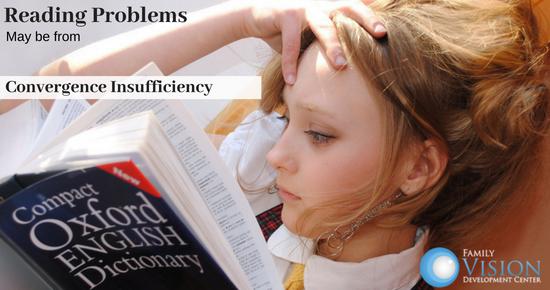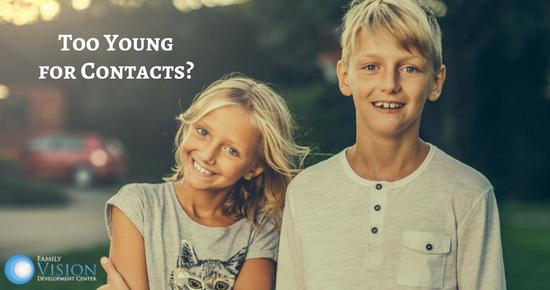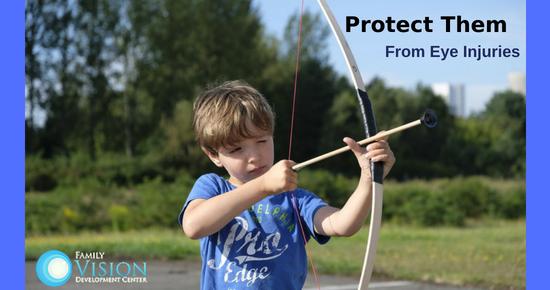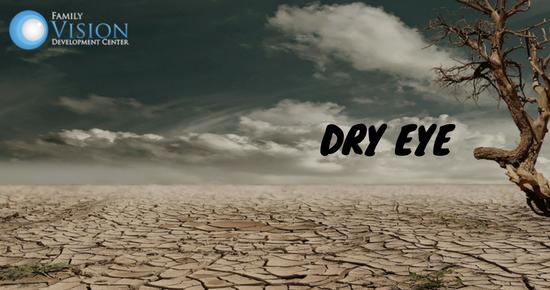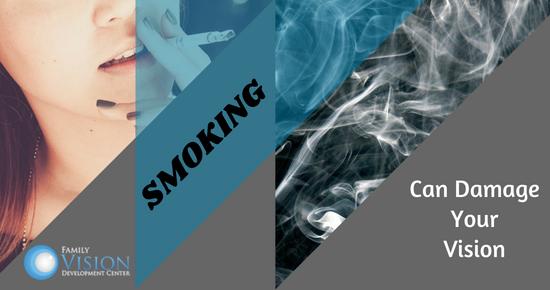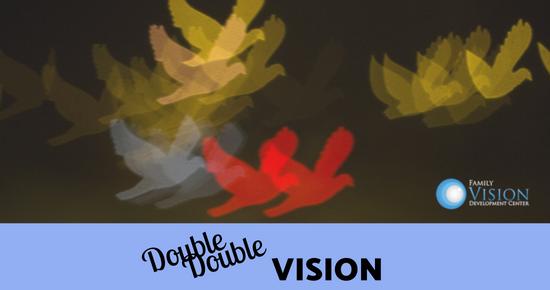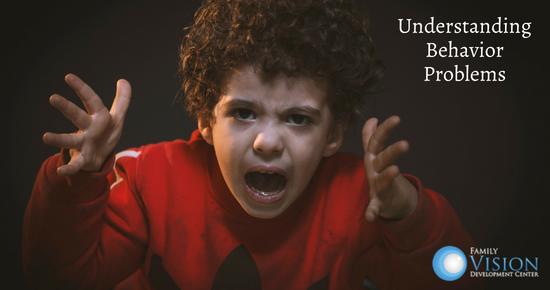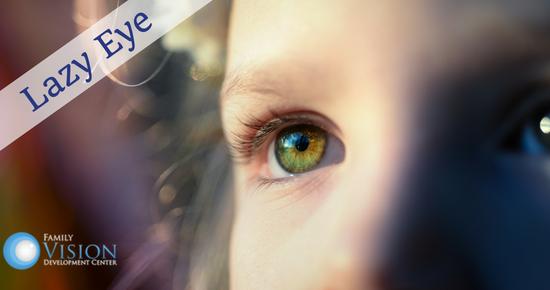Convergence insufficiency is the inability to keep both eyes working together at a close distance. To see properly, both eyes must turn inward to view objects that are near, but this condition causes one eye to turn outward. This can result in a variety of problems, and if a child suffers from this condition, the effects on their ability to learn can be profound.
Symptoms
A child with convergence insufficiency must exert more effort to bring both eyes inward while reading which can cause the following to occur:
- Sore eyes
- Headaches
- Squinting or closing one eye
- Double vision
- Difficulty concentrating or completing schoolwork
- Difficulty reading, as the words may appear to float on the page
Diagnoses
Convergence Insufficiency is typically not diagnosed in a routine vision screening that your child may have had for school. It is very important to have a thorough eye exam performed by an experienced optometrist like Dr. Martin at Family Vision Development Center. He will ask detailed questions, get a complete medical history and perform the appropriate tests in order to determine if the condition exists.
Treatment
Depending on the severity of the problem, convergence insufficiency can be treated with eyeglasses, contact lenses or vision therapy, which uses various eye-focusing exercises designed to increase the eyes’ convergence ability.
Family Vision Development Center will help you maintain your eye health at all ages, from annual eye exams to more complex issues requiring advanced treatment options. Contact us at 630-862-2020 or read more about us at www.fvdcpc.com.
Full referenced articles HERE and HERE
While some eye conditions are best treated with eyeglasses or contact lenses, some forms of vision impairment can be resolved through a treatment known as Vision Therapy. This type of physical therapy involves a series of eye exercises designed to help patients recover normal visual skills. It can improve functions such as eye tracking or movement, eye alignment, focusing or visual processing.
Who Can Benefit From Vision Therapy
Children and adults can benefit from vision therapy to treat many visual challenges such as:
- Poor binocular coordination – when 2 eyes are not working together properly, vision therapy can help develop normal coordination and teamwork of the eyes. This can be beneficial in cases of Amblyopia (lazy eye), Diplopia (double vision), Strabismus (crossed eyes), hyperopia (farsightedness), myopia (nearsightedness) or astigmatism
- Learning-related vision problems – poor visual skills can result in deficiencies in reading, writing and overall learning abilities.
- Visual problems caused by computer usage – at school, work or home, constant staring at a computer screen can lead to blurred vision, eye strain, headaches or worsening of existing eye disorders.
- Sports vision impairment – success in sports cannot be achieved without strong visual skills, including eye tracking, hand-eye coordination and peripheral vision
What Is Involved In A Vision Therapy Program
Patients typically come to the office twice weekly for 30 – 45 minutes each visit. In addition, homework is given to be done at home as reinforcement of what is learned during the office therapy sessions. Commitment to the therapy program, and maintaining a schedule of weekly visits, is important in the success of the program.
Dr. Martin at Family Vision Development Center in Aurora has specialized training in Vision Therapy and Vision Development and truly enjoys helping to restore the visual capabilities of his patients. Call Family Vision at 630-862-2020 or visit fvdcpc.com for more information.
Full referenced article HERE
A common belief is that children should not wear contact lenses under any circumstances, but that is not always the best assumption to make. There are, in fact, many beneficial reasons for a child to wear contacts. Here are some issues to consider when deciding what is right for your child:
Contacts Can Be Helpful For Sports
Contacts can provide better peripheral vision than glasses, allowing for better awareness and performance on the field or court. Contacts also eliminate the worry of glasses or frames being broken during a game and causing injury to an eye.
Contacts Can Help Your Child Feel Better
As a matter of self-esteem, some children would just prefer to wear contacts over glasses. This can lead to improved self-confidence, a more outgoing personality or better performance in school.
There Are Different Types Of Lenses
There are various types of contact lenses available, such as daily-wear soft lenses, extended-wear, extended-wear disposable or rigid gas-permeable. These options should be discussed with your optometrist, as there are advantages and disadvantages to each.
There Are Drawbacks
Contacts do require more maintenance than glasses, and some kids or teenagers may not be responsible enough to follow the care instructions given by your eye doctor. Not caring for lenses properly can lead to infections or vision loss, so if your child has a hard time remembering to do homework or chores, contacts may not be the best choice for them.
The decision to wear contacts instead of glasses should not be based on age alone, and rather on the needs of the individual child and how mature or responsible they are. It is always best to talk it over with your eye care provider to determine if contacts would be a good option for your child.
Dr. Martin at Family Vision Development Center will help you make the right choices for your child’s eyes. From contact and glasses, to vision therapy and rehabilitation, he is there to meet all of your eye health needs. Call us today at 630-862-2020 to schedule your appointment at our Aurora location.
Full referenced articles HERE and HERE
Each year, thousands of children suffer eye injuries or blindness due to accidents that could have been prevented. Safety should always be the main concern when it comes to activities that could potentially cause damage to your child’s eyes.
Injury Prevention Inside The House
Even in the safety of your own home, there are many situations that could lead to a serious eye injury. Injuries can be avoided by following these tips:
- Keeping harmful sprays or chemicals out of reach of small children
- Using caution with common items such as paper clips, pencils, scissors, wire hangers or rubber bands, as they all have the potential to cause serious eye injuries
- Providing only age-appropriate toys that meet national safety standards, and avoiding toys with sharp points like darts or arrows
- Always requiring your child to wear protective eyewear during potentially dangerous yard work or repair projects
Preventing Injuries Away From Home
It is especially important to use caution when you go out, as you have even less control of the surroundings than you do at home. Some precautions you can take to lower the risk of kids’ eye injuries while outside are:
- Children should wear protective eyewear made with polycarbonate lenses when playing sports such as baseball, basketball, racquet sports or lacrosse
- Kids should not be allowed to play with pellet or BB guns
- Fireworks are very dangerous, including bottle rockets, and children should not be anywhere near them
- Kids should be taught to be very careful around dogs while out, as dog bites account for many eye injuries
Caring For Injuries / First Aid
If an eye injury occurs, your primary care doctor or eye doctor should examine the eye as soon as possible. If chemicals are involved, the eye should be flushed out right away. In other situations, it is best to gently cover the eye and seek medical attention before applying pressure or medication, or trying to remove any imbedded object.
Family Vision Development Center in Aurora, IL is here for all of your vision needs. From routine eye exams, to investigating and diagnosing more serious conditions, and providing protective eyewear, we are experienced professionals you can trust with the care of your child’s eyes. Contact us at 630-862-2020 to schedule your appointment today.
Full referenced article HERE
The condition known as Dry Eye can cause you to experience redness, itchiness, grittiness, blurred vision or a feeling that there is something in your eye. Or conversely, it may also lead to episodes of excess tearing that follow periods of dryness, discharge or pain in the eye. There are a number of reasons that dry eye can occur and luckily there are also ways to treat it.
What Is Dry Eye
Healthy eyes typically produce tears on a continual basis. These tears are made up of a mixture of water, oils, mucus and a large number of proteins, which provide moisture and lubrication, protect against infection and keep the eyes comfortable. Dry eye occurs when the quantity or quality of tears fails to provide enough lubrication to the surface of the eye.
What Causes Dry Eye
Certain factors can contribute to the occurrence of dry eye, including the following:
- Some medications have been associated with dry eye including antihistamines, decongestants, antidepressants and high blood pressure medications
- The natural aging process can cause declines in tear production, especially in people over 50
- Certain diseases such as lupus, rheumatoid arthritis, diabetes, thyroid disorders or Vitamin A deficiencies are associated with dry eye
- Women are at a higher risk of developing dry eye due to hormonal changes during pregnancy or menopause
- Environmental factors such as wind, smoke, dryness, or seasonal allergies can lead to dry eye
Treatment For Dry Eye
An eye care professional, like Family Vision Development Center, can diagnose and offer treatment suggestions for those who are suffering from the symptoms of dry eye. Options for treatment include:
- Over-the-counter medications such as artificial tears to relieve mild symptoms
- Environmental or lifestyle changes such as reducing screen time, wearing better sunglasses to block wind or dry air, or quitting smoking
- Prescription dry eye medications
- Devices that can stimulate tear production
- Surgical options that partially or completely plug the tear ducts
Contact Family Vision to meet with Dr. Martin for relief of dry eye or for any other eye care needs. Our office is conveniently located at 452 N. Eola Rd in Aurora, IL. Use our online appointment request form or call 630-862-2020 to schedule your appointment.
Referenced article can be found HERE and HERE
Smoking is a very dangerous habit and is widely known to cause heart disease, lung cancer, emphysema and the list goes on. But many people do not realize that smoking can also have significantly damaging effects on your vision and eye health.
What Smoking Can Do To Your Eyes
Some of the ways the smoke and chemicals from tobacco use can affect your eye health include:
- Causes biological changes in your eyes that can lead to vision loss
- Interferes with the production of tears
- Reduces the amount of oxygen that gets to your eyes
- Can damage the blood vessels in your eyes
- Can increase the chance of color vision deficiency
Eye Diseases That Can Be Caused By Smoking
Smoking has been linked to many leading causes of vision loss and eye conditions such as:
- Age Related Macular Degeneration (AMD)- a leading cause of vision loss in adults 50 and over which occurs when part of the retina called the macula is damaged
- Cataracts – a clouding of the eye’s natural lens
- Diabetic Retinopathy – When high blood sugar levels cause damage to blood vessels in the retina
- Glaucoma – a condition of increased pressure within the eyeball, causing gradual loss of sight
How To Prevent Eye Damage From Smoking
The best answer, of course, is to quit smoking. Kicking this habit can greatly reduce your risk of developing some of these eye conditions that can cause vision loss. If you have never been a smoker, these examples just add to the reasons why you have made a wise choice.
Early detection is always best for your eye health, as many eye conditions can be treated more effectively if diagnosed early. A thorough eye exam is the only way to detect many eye diseases so always make regular appointments with your optometrist. Dr. Martin at Family Vision Development Center in Aurora is an experienced optometrist and vision therapist and can diagnose and treat an extensive list of eye conditions. Call 630-862-2020 to schedule your appointment or use our convenient online appointment request form.
Full referenced article HERE
Double vision, or Diplopia, occurs when a person sees a double image instead of just one. It can affect one or both eyes and can result from a variety of underlying conditions, and therefore can be difficult to diagnose and treat.
Causes Of Double Vision
Both eyes must work together in order to form a clear picture. If damage occurs to eye muscles or nerves, a double image can be created.
Monocular Double Vision Is Double Vision That Occurs In One Eye When Tested Individually. Some Conditions That Can Cause This To Occur Include:
- Astigmatism
- Dry Eye
- Abnormality of the Lens
- Abnormality of the Retina
- Cataracts
Binocular Double Vision Occurs When A Double Image Is Present Only While Both Eyes Are Open. The Following Conditions Can Lead To This Type Of Double Vision:
- Stroke
- Aneurysm
- Head Injury
- Diseases such as multiple sclerosis, diabetes, Guillain-Barre syndrome, Graves disease or thyroid disease
- Convergence insufficiency
- Childhood strabismus
Diagnosis And Treatment Of Double Vision
Because double vision can occur in one or both eyes, can be constant or variable, and can occur due to a number of possible conditions, a thorough vision examination, including a detailed medical history, must be performed to evaluate eye function, visual acuity and eye health. Once the underlying cause has been determined, the treatment is tailored to the specific condition. This can include prescription glasses or contact lenses, vision therapy or even surgery depending on the severity of the condition.
The possible causes of double vision can range from relatively harmless to life-threatening and therefore should be addressed immediately by an experienced optometrist like Dr. Martin at Family Vision Development Center. He is specially trained in advanced vision therapy techniques and will work with you to create a specific treatment plan based on your diagnosed condition.
Visit fvdcpc.com for more information or call 630-862-2020 to schedule an appointment at our Aurora location at 452 N. Eola Rd.
Full referenced articles can be found HERE and HERE
Most people understand the importance of seeing their doctor for regular exams in order to maintain their health. But seeing an eye doctor on a regular basis is just as important in order to maintain proper eye heath and preserve your vision.
Start Early
The old saying about the early bird catching the worm is an accurate one, as many eye conditions are more effectively treated the earlier they are detected. Unfortunately, many children are not getting regular eye exams, instead relying on simple vision screenings that do not detect many forms of eye disease. For example, Amblyopia, a vision development disorder, can affect 2-3% of all children. If promptly treated, vision loss can be avoided. But if left untreated, it can escalate to the point of legal blindness.
Continued Vision Care
As you age, regular eye exams can detect many eye diseases that can cause serious damage if not treated such as:
- Cataracts
- Diabetic retinopathy
- Glaucoma
- Age-related macular degeneration
Many eye diseases start without any symptoms and therefore go unnoticed for long periods of time, making treatment options more difficult in some cases. A comprehensive eye exam is the best way to detect these diseases in their early stages when treatment is most effective for preventing vision loss.
Recommended Frequency Of Eye Exams
- Children should have regular eye exams to detect common diseases that need early treatment. The recommended ages for eye exams for children are 6 months, 3 years old and before kindergarten. They should be performed yearly after age 5.
- People with diabetes and those at higher risk for Glaucoma should get a dilated eye exam every year
Regular visits to your optometrist can keep your vision strong throughout your life. Contact Family Vision Development Center in Aurora to schedule an appointment for each of your family members to get started on better eye health. Use our convenient online appointment request form, call us at 630-862-2020 or visit fvdcpc.com for more information.
Full referenced article HERE
Teachers think your child has trouble paying attention in class?
The Reason May Be Their Vision!
Many classroom concerns can actually be attributed to treatable vision conditions. Inattentiveness, frustration, lack of organization, acting out in class and many other behavioral issues can be linked to eye conditions such as:
- Nearsightedness
- Farsightedness
- Amblyopia (lazy eye)
- Strabismus (crossed eyes)
- Astigmatism (blurry vision)
- Convergence Insufficiency
- Problems with tracking or visual perception
Eye Problems Lead To More Problems
The presence of one of these vision problems can cause a child to experience headaches, eye fatigue, dizziness, poor coordination, or poor concentration and comprehension. The resulting frustration can lead to poor self-esteem and lack of confidence which can cause children to act out in negative ways such as through anger, bullying or fighting.
Solutions Start With Therapy
Vision Therapy, a form of physical therapy for the eyes, is an extremely effective treatment option for any of these conditions and involves a series of eye exercises that help patients develop or recover normal visual skills. Family Vision Development Center in Aurora will evaluate your child with a thorough eye exam and develop a treatment plan designed to correct their specific problem. Call us at 630-862-2020 or visit fvdcpc.com to learn more or to schedule an appointment using our online request form.
Referenced article can be found HERE
That Blurry Vision Could be Lazy Eye
If your child is experiencing signs of blurry vision or lack of depth perception, they might be suffering from Amblyopia, or “lazy eye”. Lazy eye means that one eye does not see as clearly as the other, even with glasses or contact lenses, and sometimes may involve a crossing or turning of the eyes. This type of eye condition is not completely treatable with eyeglasses or contact lenses and often requires vision therapy.
Vision Therapy Is A Successful Treatment Option For Lazy Eye
Vision Therapy for Amblyopia involves special vision training for the eyes, medically proven to be an effective form of treatment. After a preliminary evaluation at The Family Vision Development Center, Dr. Martin will determine the appropriate therapy program designed to treat your child’s specific vision needs.
Early Detection Is Best
Amblyopia is treatable at any age, from infant to adult. However, the earlier a diagnosis is made and treatment started, the better the chance of favorable results from therapy. That is why regular eye exams and communication with your optometrist is so important for early detection of a problem. Contact Family Vision Development Center in Aurora at 630-862-2020 to schedule your appointment today.
Information referenced from this article
